2017 Ducati Supersport Review

MO's First Ride aboard Ducati's sensible sportbike
In 2015 I wrote a column about how Sportbikes Are Terrible. In short, I felt (and still do) that production sportbikes have become so focused on the racetrack that riding them on the street anywhere other than a curvy road is borderline torture. Take either of the Ducati Panigale variants, for example. Rolling works of art, on a track they are some of the most fun you can have on two wheels. But would I want to ride one a few hours to the track, do a trackday, then ride home?
2017 Ducati Supersport
| Engine | 19.0/20 |
| Suspension/Handling | 13.5/15 |
| Transmission/Clutch | 8.0/10 |
| Brakes | 8.0/10 |
| Instruments/Controls | 4.0/5 |
| Ergonomics/Comfort | 9.0/10 |
| Appearance/Quality | 9.0/10 |
| Desirability | 9.0/10 |
| Value | 7.0/10 |
| Overall Score | 86.5/100 |
Not just no, but hell no.
Apparently I’m not the only one who feels this way: introducing the 2017 Ducati Supersport. Offering a motorcycle nearly as pretty as the Panigale, with all-day comfort and a slice of the 1299’s performance chops – Ducati calls the Supersport the model for those who lean more toward the sport side of sport-touring.
Really, the Supersport shouldn’t be much of a surprise, as we first posted a leaked photo of the Ducati Supersport back in July of 2016. The bike was shown to attendees of World Ducati Week with a strict no-cameras policy, but unsurprisingly, a “mole” (if you believed this photo was staged) was able to snap a pic and distribute it to the world via social media. The rumor mill then ignited with possible specs for the Supersport and, I’ll admit, I got caught up, too.
The guesswork came to an end in October 2016, as Ducati finally took the official wraps off the Supersport and Supersport S at Intermot. Beyond being a sporty sport-tourer, what we found could arguably be described as the ideal middleweight sportbike – if you’re willing to let go of the notion that middleweights have to be 600cc Fours. We’ve already covered the technical details of the Supersport after its Intermot unveiling, but here are the key points:
- Power is sourced from the 937cc Testastretta 11º found in the Hypermotard. The 937cc Twin delivered 101 hp and 67 lb-ft of torque to the wheel when we sampled it in our 2017 Ducati Hypermotard review, making it perfect for its intended role in the Supersport.
- The engine is mated to a new steel-trellis frame. To accommodate, the 937cc V-Twin received a new crankcase, cylinder heads, generator cover, and external coils.
- Base model gets Marzocchi fork (fully adjustable) and Sachs rear shock (rebound and preload adjustable)
- Uprated S model gets Öhlins shock and 48mm TiN-treated fork, quickshifter for both up and downshifts (optional on base model), and a solo seat cowl.
- Both versions get Brembo M432 radial-mount calipers with a Brembo PR18/19 front master cylinder
- Both versions get Bosch ABS and eight-level traction control
Crucially, what makes the Supersport an ideal companion for the street and track is its relatively relaxed ergos. Clip-ons are placed above the top triple clamp, its 31.8-inch seat height is 0.78 inch lower than the Panigale’s, and the pegs have been placed in a more comfortable position versus the Panigale as well. Even the windscreen is adjustable to two positions for user comfort.
Despite those comfort items, the Supersport still has the ingredients to slice up a canyon road and set some quick laps, too – it is a Ducati, after all. With a 24.0° rake, 3.68-inch trail and 58.3-inch wheelbase, compare that to the 1299 Panigale’s figures of 24.0º, 3.78 inches, and 56.6 inches, respectively. Clearly, the sporting chops are still there.
Ducati doesn’t categorize the Supersport as an entry-level Panigale. Instead, Bologna believes the Supersport and Supersport S fill a gap in the company’s lineup between the Panigale and Multistrada. It’s a model with unmistakeable sportbike aesthetics that doesn’t alienate those who still want to travel some distance on it. Whether you want to call it a sporty-bike or a sporty-tourer, the question remains: Does it work?
A Streetable Sportbike
The simple answer is yes, it absolutely works. But if you’re expecting a motorcycle like the past Supersports of a decade (or more) ago, then you should change your expectations. Ducati says the latest iteration of the Supersport isn’t a modern day interpretation of an old name, but instead a new direction. Ducati’s out to prove comfort and sport are not mutually exclusive.
Looking at the bike, it’s clear to see by the Panigale-inspired nose and elegant bodywork that the Supersport is ready for a curvy road. Once you’re sitting on it, the message of comfort also makes itself known. The narrow seat/tank junction feels as though you’re nearly touching your knees together, which makes it easy to put both feet on the ground. The seat itself is broad and fairly well padded once you scoot back a smidge.
Comfort is further illustrated when you reach for the bars, as you’re not splayed out over the fuel tank. Instead, the high bars place the rider in a natural posture, with only a slight forward lean. Wrist pressure is minimal, which is what you want if burning up miles en route to twisty roads is the goal. I was pleasantly surprised, too, when reaching back for the footpegs as I would for a Panigale, only to find nothing back there. Relaxing my knees a bit and reaching forward placed toes on pegs. Ahhh…
On the roads in and around Seville, the Supersport’s beauty and functionality come into view. A less intimidating mileage cruncher compared to the Multistrada, its smaller dimensions are easier to manage and the 937cc Testastretta V-Twin is lively and athletic, producing just the right amount of power to have fun but not be intimidating – the Goldilocks effect, if you will. Clutch pull is light, though a little slippage is needed to leave a stop.
Three ride modes are available (Sport, Touring, Urban) thanks to ride-by-wire technology, with full power available in Sport and Touring. As the name would imply, the latter meters out a gentle delivery of power with the first few degrees of throttle turn, while Sport gives the full dose from the off. Urban, meanwhile, limits the Supersport to 75 hp and really soft power delivery. Touring was initially selected for our street ride, as Sport mode on past Ducatis have sometimes been too aggressive for casual riding.
Fuel is metered precisely no matter the ride mode, but I found myself wanting for just a touch more power during the initial twist of the wrist in Touring mode. Switching to Sport halfway through the ride gave a much more immediate burst of power without being too harsh or abrupt. I liked it so much it became my default setting for the rest of the ride. ABS and traction control are tied into each ride mode, but can be adjusted independently from the menu screen.
Once above 4,000 rpm, the Supersport really starts to sing. It’s belting out something in the region of 101 hp and 67 lb-ft to the wheel, based on the 937 in the last Hypermotard we tested, and Ducati claims 80% of the bike’s torque is available from 3,000 rpm. This playful character makes the Supersport a riot in the canyons, with readily available propulsion that gently pushes you forward instead of snapping you back, like on the 1299 Panigale. Simply put, you’re the one riding the bike. Not the other way around.
Rowing through the six cogs is easy enough. Ratios are identical to the Hypermotard, but according to Giuseppe Caprara, Supersport Project Leader, the gears themselves have been strengthened compared to the Hyper to better handle the stress from the quickshifter, which works in both directions and comes standard on the S model. The standard models we rode for the street ride were not equipped with the quickshifter, but it wasn’t much of a problem. Clutchless upshifts go on without a hitch, and a slipper clutch helps mask any mistakes made changing down.
As fun and athletic as the engine is, the Supersport is blessed with a chassis and supporting cast that are equally down to party. Its trellis frame is derived from the Monster line, with Marzocchi supplying the fully adjustable fork and Sachs delivering the shock with preload and rebound adjustability. Tires are Pirelli Diablo Rosso III measuring 120/70-17 front, 180/55-17 rear – the latter size chosen specifically to highlight the Supersport’s agility, says Caprara.
More than just marketing speak, the Supersport really is a light and agile motorcycle, willing to change direction quickly. The sinuous Spanish roads Ducati chose as part of the ride route brought this into clear focus, as flicking the Supersport’s 463 pounds from side to side was effortless – an attribute no doubt helped by the positioning of the bars, which are wide enough to give just the right amount of leverage to toss the bike around. Once on its side, the chassis/suspension/tire combination feels sure and planted.
If you ask me, Ducati nailed it with the Supersport. Fun, quick, and unintimidating it’s a great real-world Ducati for those who want to combine elements of sportiness from the Panigale, approachability of the Monster, and touring ability of the Multistrada. That said, the bike isn’t without its sore spots.
First, as a bike claiming to be flexible enough for touring, the twin 22-liter saddlebags are part of the optional Touring Pack available from Ducati. Other bits of the Touring Pack include a taller windscreen and heated grips. Speaking of which, buzz from the Supersport does start to make the hands go numb when you’re playing in the upper third of the rev range (common when strafing canyons at a quick clip). Lastly, it seems Ducati missed an obvious opportunity by not equipping the Supersport with cruise control. Throttle is ride-by-wire anyway; for a bike capable of some light touring, cruise control should be a no-brainer.
The New Middleweight
The Supersport may be a road-going motorcycle first and foremost, but Ducati has racing in its blood, so it couldn’t just have a single version of a model. Hence the Supersport S. Distinguished by its matte white color (but also available in Red), matching solo seat cowl, fully adjustable Öhlins suspension, and Ducati Quick Shifter (DQS), the S version further highlights the sporting chops of the bike without sacrificing its light-duty touring potential.
To take full advantage of the Supersport S, a racetrack is needed, Ducati shuttled us to the Circuito Monteblanco to fully explore the limits. With only two 20-minute sessions at our disposal, it was important to learn the track quickly. Fortunately, the relatively docile Supersport S made this easy to do, as its modest power doesn’t overwhelm the senses, allowing me to spare a few precious brain cells to figure out my lefts from my rights.
Once up to speed, the Supersport S is just as enjoyable on track as the standard model was on the roads. Without crazy horsepower to manage, liberal amounts of throttle can be applied exiting a corner as the bike is picked up and accelerating on the fat part of the tire. The rear Diablo Rosso III protests quickly when ridden this way, squirming and sliding as it copes with the rider’s request, but the Ducati Traction Control (set to level 3 of 8 in my case), keeps everything under control. Without it, I’d likely still be in orbit as you read this.
If you’re the type to be more cautious as you navigate bends, the Supersport’s excellent fueling means careful throttle inputs are met without harsh abruptness during on/off throttle inputs. Around a racetrack, the Supersport favors corner speed and momentum to make up for its modest power. Just like on the street, the SS has no problem changing directions, the wide bars providing ample leverage. More impressive was not feeling much of a difference between the Marzocchi/Sachs suspenders on the standard model and the Öhlins bits on the S. This isn’t a knock on Öhlins as much as it is a credit to Marzocchi and Sachs. Granted, our time aboard the S was very short, so a more thorough assessment of the suspension will have to wait until we get one Stateside.
Either way, the bike feels composed and stable – the tires being the limiting factor in this equation for anyone truly wanting to set fast laps. There’s plenty of room to move about the saddle, and when raised to its higher position, the windscreen even provides a decent pocket of still air for the pilot to tuck into.
Because we were able to ride the bike on the track, I can’t help but think the Supersport represents a shift in thinking of what a middleweight bike is. As I mentioned earlier, if you erase the notion that a middleweight has to be a 600cc Four (or 675 Triple), the Supersport satisfies many of the same qualities; it feels roughly as quick as a 600, it feels lighter than its 463 lbs would make you believe, and it’s less demanding both physically and mentally than a liter-class racer. Or even the 959 Panigale, for that matter. It’s even priced similarly to the 600 competition, too: standard Supersports start at $12,995, S models $14,995. Compare that with the $12,199 price tag for the new Yamaha R6 (or $14,999 for the R1S).
As much as I like the S model, there are a few (albeit minor) complaints I noticed on track. The 320mm rotors and Brembo M432 calipers provide decent braking power, but it could use a little more. Feel at the lever was lacking as well. Make no mistake, it will stop just fine with a hard enough squeeze, but the M432 calipers are akin to a paint gun compared to the air brush of the M50s used on the 1299 Panigale. Perhaps, something as simple as a pad change would go a long way.
Along that line, the ABS can be too intrusive. Fortunately, it’s adjustable to three different settings (four, including off). Set to level 2 during our initial track outing, the ABS would kick in aggressively, especially while braking for Turn 1, which comes at the end of a very long straight, just as the Supersport touches the rev limiter in top gear. ABS is working hard at both ends to keep the wheels from locking, but it’s also taking away feel at the lever that lets the rider find that threshold himself. Setting ABS to level 1 disables it in the rear, allowing for rear tire slides; It’s not the fast way into the corner, but it sure is fun. Still, engagement in the front occurs slightly too soon for my taste, but it’s really a minor nitpick.
The Ducati quickshifter also felt as though it was tuned for the street rather than the track. Kill times were just a hair too long during upshifts, and clutchless downshifts felt notchy and slightly too slow for track duty. Ultimately, I went old school and downshifted with the clutch lever.
Lastly, changing any of the settings from the LCD menu screen requires requires a degree in computer science. I applaud Ducati for giving the Supersport plenty of tunability within the settings, but navigating the screens and making changes requires numerous screens and button presses to wade through; you won’t be making any changes on the fly.
One Bike To Do It All
In the overall scheme of things, those complaints are fairly minor. The bigger thing to keep in mind here is that, as motorcycles have become more and more specialized, Ducati has set out to create a motorcycle to bring things back to the way they were. With the Supersport and Supersport S, the street rider really does have a bike capable of fulfilling all their needs. Whether it’s commuting, weekend rides, touring, or even trackdays, the Supersport can handle it and handle it well.
Personally, I agree. Ducati named the Suzuki GSX-S1000 as something remotely close to a competitor, but I think we can all agree the Gixxus doesn’t match the Supersport for looks, and its passenger accommodations are rather slim. While I didn’t ride on the back of the Supersport, I did sit back there while parked and agree it’s broad and well padded. Perhaps its nearest Japanese analog is the VFR800 Interceptor, which was dropped from American Honda’s lineup in 2015.
The beauty of Ducati’s Supersport models is their flexibility to suit riders of all skill levels. Nearly anyone can ride it in the manner that suits them and come away satisfied. As it turns out, the group of journos assembled this day ranged from MotoAmerica pro racers to a first-time track rider, and everyone in between. All of them, myself included, walked away happy and with a big grin on their face.
2017 Ducati Supersport
+ Highs
- Goldilocks engine
- All-day comfort
- Can easily hold its own on track or in the canyons
– Sighs
- Menu screens aren’t intuitive
- Brakes could use a bit more power and feel
- A little pricey…
Whether you lean more towards sport or touring, the Supersport offers something to like for almost everyone. Touring riders looking for something smaller and lighter than a Multistrada will be pleased, as will sport riders looking for a less hardcore kind of middleweight. The beauty of the Supersport is the ability to modify and accessorize it to better accomplish either.
As for me, I think I’ve found my new favorite Ducati. I’d even ride it to a trackday, burn laps, and ride home.
2017 Ducati Supersport | 2017 Ducati Supersport S | |
|---|---|---|
| MSRP | $12,995 | $14,995 |
| Horsepower | 113 hp @ 9,000 rpm (claimed) | 113 hp @ 9,000 rpm (claimed) |
| Torque | 71.3 lb.-ft. @ 6,500 rpm (claimed) | 71.3 lb.-ft. @ 6,500 rpm (claimed) |
| Engine Capacity | 937cc | 937cc |
| Engine Type | Testastretta 11°, L-Twin cylinder, 4 valve per cylinder, Desmodromic, liquid cooled | Testastretta 11°, L-Twin cylinder, 4 valve per cylinder, Desmodromic, liquid cooled |
| Bore x Stroke | 94.0 x 67.5 mm | 94.0 x 67.5 mm |
| Compression | 12.6± 0.5 :1 | 12.6± 0.5 :1 |
| Fuel System | Continental electronic fuel injection system, 53 mm Mikuni throttle bodies with full Ride-by-Wire | Continental electronic fuel injection system, 53 mm Mikuni throttle bodies with full Ride-by-Wire |
| Transmission | 6-speed | 6-speed |
| Clutch | Multi-plate wet clutch with mechanical slipper system & quick-shifter | Multi-plate PASC slipper clutch |
| Final Drive | Chain | Chain |
| Frame | Tubular steel Trellis frame attached to the chylinders head | Tubular steel Trellis frame attached to the chylinders head |
| Front Suspension | Fully adjustable 43mm (1.7 in) usd Marzocchi forks | Fully adjustable 48mm (1.9 in) usd Ohlins forks |
| Rear Suspension | Progressive linkage with adjustable Sachs monoshock. Aluminium single-sided swingarm | Progressive linkage with fully adjustable Ohlins monoshock. Aluminium single- sided swingarm |
| Front Brakes | 2 x 320 mm (12.6 in) semi-floating discs, radially mounted Monobloc Brembo M4- 32 callipers, 4-piston, radial pump with ABS as standard | 2 x 320 mm (12.6 in) semi-floating discs, radially mounted Monobloc Brembo M4- 32 callipers, 4-piston, radial pump with ABS as standard |
| Rear Brakes | 245 mm (9.6 in) disc, 2-piston caliper, ABS as standard | 245 mm (9.6 in) disc, 2-piston caliper, ABS as standard |
| Front Tire | Pirelli Diablo Rosso III 120/70 ZR17 | Pirelli Diablo Rosso III 120/70 ZR17 |
| Rear Tire | Pirelli Diablo Rosso III 180/55 ZR17 | Pirelli Diablo Rosso III 180/55 ZR17 |
| Seat Height | 31.9 inches | 31.9 inches |
| Wheelbase | 58.2 inches | 58.2 inches |
| Rake/Trail | 24.0º/ 3.6 inches | 24.0° / 3.6 inches |
| Curb Weight (fully fueled) | 463 pounds | 463 pounds |
| Fuel Capacity | 4.2 gal. | 4.2 gal. |
| MPG | 35.4 mpg | 38.4 mpg |
| Electronics | Riding Modes, Power Modes, Ducati Safety Pack (ABS + DTC), RbW. Ready for anti-theft system | Riding Modes, Power Modes, Ducati Safety Pack (ABS + DTC), RbW, DQS. Ready for anti-theft system |
| Colors | Red | Matte White, Red |
| Warranty | 24 months unlimited mileage | 24 months unlimited mileage |

Troy's been riding motorcycles and writing about them since 2006, getting his start at Rider Magazine. From there, he moved to Sport Rider Magazine before finally landing at Motorcycle.com in 2011. A lifelong gearhead who didn't fully immerse himself in motorcycles until his teenage years, Troy's interests have always been in technology, performance, and going fast. Naturally, racing was the perfect avenue to combine all three. Troy has been racing nearly as long as he's been riding and has competed at the AMA national level. He's also won multiple club races throughout the country, culminating in a Utah Sport Bike Association championship in 2011. He has been invited as a guest instructor for the Yamaha Champions Riding School, and when he's not out riding, he's either wrenching on bikes or watching MotoGP.
More by Troy Siahaan



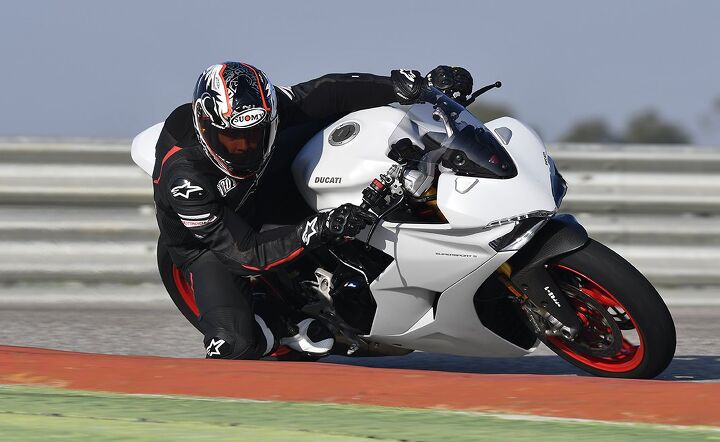
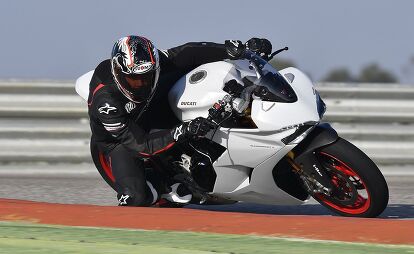











































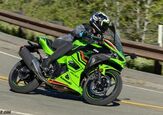
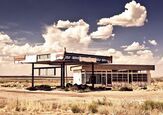

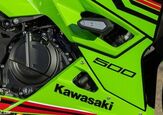
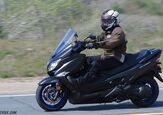
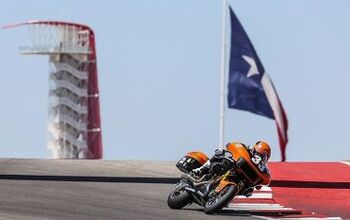

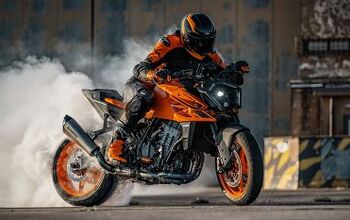
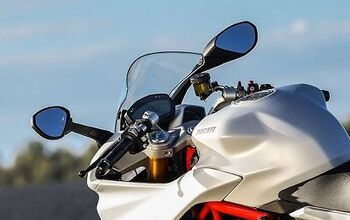
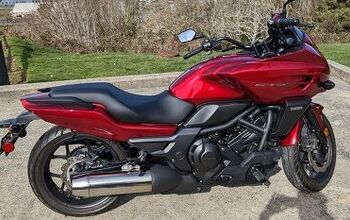

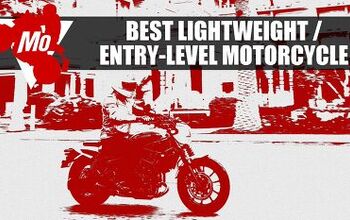
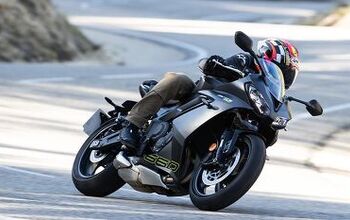
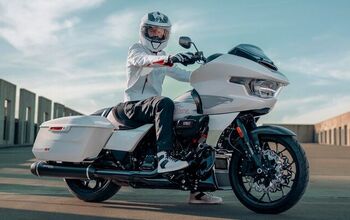
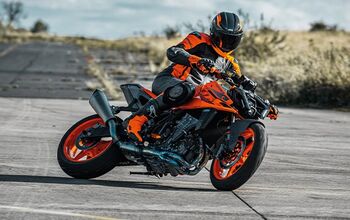
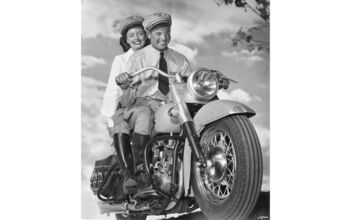
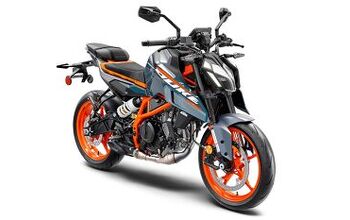

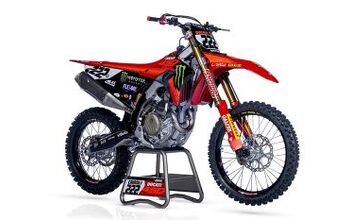
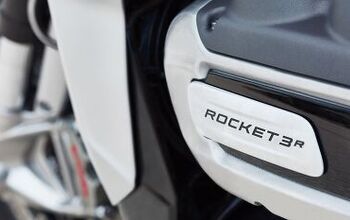
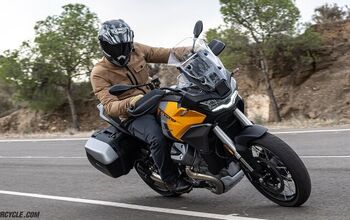
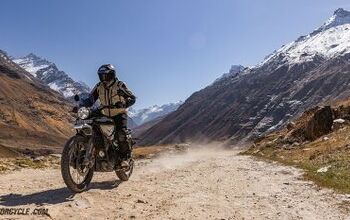
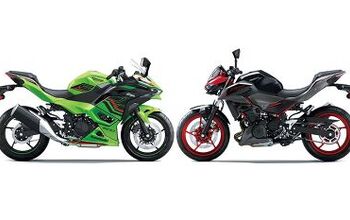
Comments
Join the conversation
Sounds like my kind of motorcycle but should have **10-20 more hp** ( monster 1200 motor ) and a **5 gal gas tank** would make this the ultimate sport tourer!!!!. I will have to see when they do a full test but so far everybody is saying the same thing with that motor it's over priced with my recommendations I would go over my price point say 16-17K!! Maybe that new triumph 765 and find a fairing to match the bike?
Just bought one so far seems like what they say good all around sportbike but those mirrors are just useless other wise great bike so far with my 35 years of riding everything from 85' interceptor to the monster ZX 14R ...............
https://uploads.disquscdn.c...